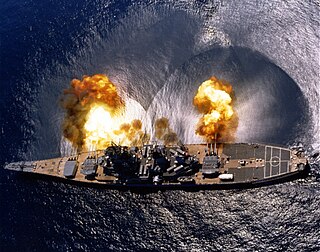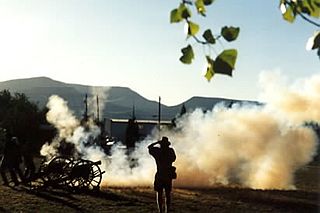A cannon is a large-caliber gun classified as a type of artillery, which usually launches a projectile using explosive chemical propellant. Gunpowder was the primary propellant before the invention of smokeless powder during the late 19th century. Cannons vary in gauge, effective range, mobility, rate of fire, angle of fire and firepower; different forms of cannon combine and balance these attributes in varying degrees, depending on their intended use on the battlefield. A cannon is a type of heavy artillery weapon.

The Charleville musket was a .69 caliber standard French infantry musket used in the 18th and 19th centuries. It was made in 1717 and was last produced during the 1840s. However, it still saw limited use in conflicts through the mid-19th century.

A matchlock or firelock is a historical type of firearm wherein the gunpowder is ignited by a burning piece of flammable cord or twine that is touched to the gunpowder by a mechanism that the musketeer activates by pulling a lever or trigger with his finger. This firing mechanism was an improvement over the hand cannon, which lacked a trigger and required the musketeer or an assistant to apply a match directly to the gunpowder by hand. The matchlock mechanism allowed the musketeer to apply the match himself without losing his concentration.

The wall gun or wall piece was a type of smoothbore firearm used in the 16th through 18th centuries by defending forces to break the advance of enemy troops. Essentially, it was a scaled-up version of the army's standard infantry musket, operating under the same principles, but with a bore of up to one-inch (25.4 mm) calibre. These weapons filled a gap in firepower between the musket and the lightest artillery pieces, such as the swivel gun. This sort of weapon may also be found described as a rampart gun, hackbut or amusette, a name originally given to early medieval hand cannon.

The flintlock mechanism is a type of lock used on muskets, rifles, and pistols from the early 17th to the mid-19th century. It is commonly referred to as a "flintlock". The term is also used for the weapons themselves as a whole, and not just the lock mechanism.

Slow match, also called match cord, is the slow-burning cord or twine fuse used by early gunpowder musketeers, artillerymen, and soldiers to ignite matchlock muskets, cannons, shells, and petards. Slow matches were most suitable for use around black-powder weapons because a slow match could be roughly handled without going out, and only presented a small glowing tip instead of a large flame that risked igniting nearby gunpowder. Slow match of various types was one of the first kinds of artillery fuse.

A pistol sword is a sword with a pistol or revolver attached, usually alongside the blade. It differs from a rifle with a bayonet attached, in that the weapon is designed primarily for use as a sword, and the firearm component is typically considered a secondary weapon designed to be an addition to the blade, rather than the sword being a secondary addition to the pistol. In addition, the two components of these weapons typically cannot be separated, unlike most bayonets mounted on rifles.

Naval artillery is artillery mounted on a warship, originally used only for naval warfare and then subsequently used for more specialized roles in surface warfare such as naval gunfire support (NGFS) and anti-aircraft warfare (AAW) engagements. The term generally refers to powder-launched projectile-firing weapons and excludes self-propelled projectiles such as torpedoes, rockets, and missiles and those simply dropped overboard such as depth charges and naval mines.

A touch hole, also known as a cannon vent, is a small hole at the rear (breech) portion of the barrel of a muzzleloading gun or cannon. The hole provides external access of an ignition spark into the breech chamber of the barrel, either with a slow match (matchlock), a linstock or a flash pan ignited by some type of pyrite- (wheellock) or flint-based gunlock, which will initiate the combustion of the main gunpowder charge. Without touch hole, it would be nearly impossible to ignite the powder because the only otherwise access into the barrel is from the front via the muzzle, which is obturated by the projectile.

A culverin was initially an ancestor of the hand-held arquebus, but later was used to describe a type of medieval and Renaissance cannon. The term is derived from the antiquated "culuering" and the French "couleuvrine" From its origin as a hand-held weapon it was adapted for use as artillery by the French in the 15th century, and for naval use by the English in the 16th century. The culverin as an artillery piece had a long smoothbore barrel with a relatively long range and flat trajectory, using solid round shot projectiles with high muzzle velocity.

The Puckle gun was a primitive crew-served, manually-operated flintlock revolver patented in 1718 by James Puckle (1667–1724), a British inventor, lawyer and writer. It was one of the earliest weapons to be referred to as a "machine gun", being called such in a 1722 shipping manifest, though its operation does not match the modern use of the term. It was never used during any combat operation or war. Production was highly limited and may have been as few as two guns.
Naval artillery in the Age of Sail encompasses the period of roughly 1571–1862: when large, sail-powered wooden naval warships dominated the high seas, mounting a large variety of types and sizes of cannon as their main armament. By modern standards, these cannon were extremely inefficient, difficult to load, and short ranged. These characteristics, along with the handling and seamanship of the ships that mounted them, defined the environment in which the naval tactics in the Age of Sail developed.

Gunpowder artillery in the Middle Ages primarily consisted of the introduction of the cannon, large tubular firearms designed to fire a heavy projectile over a long distance. Guns, bombs, rockets and cannons were first invented in China during the Han and Song dynasties and then later spread to Europe and the Middle East during the period.

Cannon operation required specialised crew and gunners, who were first enlisted by the Spanish in the 14th century. The nature of cannon operation often depended on the size of the cannon and whether they were breech-loading or muzzle-loading. English cannons of the late 14th century became mobile, while the largest cannon required huge crews to transport and operate them.

Military forces of the Ottoman Empire used a variety of weapons throughout the centuries. The armoury in Topkapı Palace has a large collection of which it shows select items.
The Springfield Model 1847 was a percussion lock musketoon produced by the Springfield Armory in the mid-19th century.
In firearms and artillery, the primer is the chemical and/or device responsible for initiating the propellant combustion that will propel the projectiles out of the gun barrel.
The M1752 Musket was a muzzle-loading firearm invented in 1752 and used by the Spanish Army from then until it was widely replaced by the much more effective Minié rifles during the mid-19th century. The M1752 was the first standardized long gun utilized by the Spanish military and was deployed in Spain's American colonies, where it saw action during the Battle of Havana. Spain also provided around 10,000 up to 12,000 muskets to the American rebels during the Revolutionary War.

The 36-pounder long gun was the largest piece of artillery mounted on French warships of the Age of Sail. They were also used for Coastal defense and fortification. They largely exceeded the heaviest guns fielded by the Army, which were 24-pounder long guns. The nominal weight of shot was 36 French livres, 17.6 kg (38.8 lb).
The Potzdam musket was the standard infantry weapon of the Royal Prussian Army from the 18th century until the military reforms of the 1840s. Four models were produced—in 1723, 1740, 1809 and 1831.














